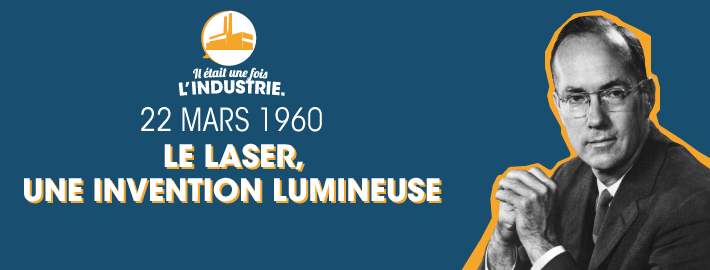GLOBAL
INDUSTRIE
News
Share on

22 March 1960: laser, a brilliant invention
This week will mark the 62nd anniversary of the patenting of the laser by two American researchers. This article will try to shed some light on this invention.
A PROJECT COOKED UP WITH A MICROWAVE
Charles Townes was 44 when, on the 22nd of March 1960, together with his brother-in-law Arthur Schawlow, he filed a patent which, although it was to reshape industry and the world in general, was the result of research work started nearly twenty years earlier. It was during World War II that the young physicist had the opportunity to work on radar-assisted bombing systems. He familiarized himself at this time with microwave generating devices, which fascinated him, and had an idea which was to prove to be revolutionary: using stimulated emission, a process devised by a certain Albert Einstein, to obtain a beam of identical photons by amplifying an electromagnetic wave. With this in mind, he manufactured, with two colleagues at the University of Columbia, a device for amplification of microwaves by stimulated emission of radiation, which he called a “maser”. This device succeeded for the first time in emitting a coherent beam of microwaves, ideal in metrology in particular.
Far from resting on his laurels, he then teamed up with his brother-in-law, also a physicist, to go for the next step, publishing in 1958 an article laying the foundations for the amplification of visible light by stimulated emission of radiation.
MALIBU RESCUE
Putting theory into practice was a giant step, however, which tripped up renowned scientists, including such leading lights as the Soviet physicists Nikolai Bassov and Aleksandr Prokhorov. Although everyone made their contribution, it was eventually a young 32-year-old researcher working in a small Californian laboratory in Malibu, Theodore Maiman, who was the first to succeed in producing the first laser using a ruby rod two year later in 1960. This invention was described as “trivial” by his superior, who initially saw this perfectly rectilinear amplified light beam, obtained using the laws of quantum mechanics, as merely a trivial variation on Townes’s idea… A year later, the Iranian-American physicist Ali Javan created the first gas laser, followed in 1966 by the Russian-American Peter Sorokin with the first liquid laser.
It was Townes, Bassov and Prokhorov, however, who were awarded the Nobel Prize for Physics in 1964 “for fundamental work in the field of quantum electronics, which has led to the construction of oscillators and amplifiers based on the maser-laser principle.” It was indeed the latter name which was given to these devices at the time, in tribute to the fundamental discovery of the “maser”.
RUBY IN THE SKY WITH DIAMONDS
Industry was not slow to seize on these discoveries. In 1965, a hole 4.7 mm in diameter and 2 mm deep was successfully drilled in diamond using a ruby laser in 15 minutes instead of the 24 hours which had been required up to then. In 1967, Peter Holcroft succeeded in cutting a 2.5 mm thick stainless steel plate at a rate of one meter per minute, designing the first cutting head at the same time. It was not however until a little over ten years later, in the late 1970s, that these processes were combined with machines suitable for installation in an industrial environment. Over the following decade, laser became predominant in micro-machining thanks to its high speed without any contact or tool wear.
Being capable of reading an increasing number of data, it also established itself as part of everyday life with barcode readers in 1974 and then with laser discs in 1978, optical disks becoming genuinely commonplace from 1982 onwards with the CD. At the center of a global market worth billions of dollars, lasers now shine everywhere in our daily lives.
Sources: CNRS and Wikipedia
2022.03.21